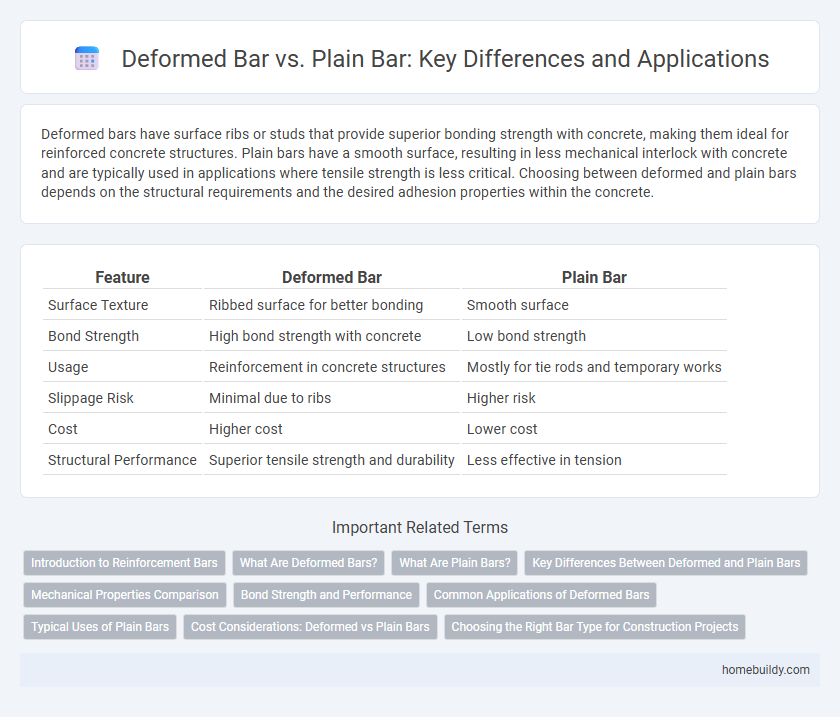Deformed bars have surface ribs or studs that provide superior bonding strength with concrete, making them ideal for reinforced concrete structures. Plain bars have a smooth surface, resulting in less mechanical interlock with concrete and are typically used in applications where tensile strength is less critical. Choosing between deformed and plain bars depends on the structural requirements and the desired adhesion properties within the concrete.
Table of Comparison
| Feature | Deformed Bar | Plain Bar |
|---|---|---|
| Surface Texture | Ribbed surface for better bonding | Smooth surface |
| Bond Strength | High bond strength with concrete | Low bond strength |
| Usage | Reinforcement in concrete structures | Mostly for tie rods and temporary works |
| Slippage Risk | Minimal due to ribs | Higher risk |
| Cost | Higher cost | Lower cost |
| Structural Performance | Superior tensile strength and durability | Less effective in tension |
Introduction to Reinforcement Bars
Reinforcement bars, commonly known as rebars, are essential in enhancing the tensile strength of concrete structures. Deformed bars feature surface ridges that improve mechanical bonding with concrete, whereas plain bars have smooth surfaces and provide less grip. The choice between deformed and plain bars significantly impacts structural stability and durability in construction projects.
What Are Deformed Bars?
Deformed bars are steel reinforcing bars with surface ribs or patterns designed to improve bonding with concrete, enhancing structural strength and stability. Unlike plain bars, which have smooth surfaces, the deformations on these bars prevent slippage within the concrete, ensuring better load transfer and durability in construction. These bars are essential in reinforced concrete structures due to their superior mechanical adhesion properties.
What Are Plain Bars?
Plain bars are smooth steel rods used in construction, primarily for light reinforcement where minimal bond strength with concrete is required. Unlike deformed bars, plain bars lack surface ribs or indentations, resulting in lower mechanical interlock with concrete. Their applications include tie rods, dowels, and light structural elements where tension forces are minimal.
Key Differences Between Deformed and Plain Bars
Deformed bars feature surface ribs or indentations designed to enhance the mechanical bond with concrete, providing superior tensile strength compared to smooth plain bars. Plain bars lack these surface deformations, resulting in lower bonding capacity and often requiring additional anchorage measures in structural applications. The choice between deformed and plain bars directly impacts concrete adhesion, load transfer efficiency, and overall structural integrity in reinforced concrete constructions.
Mechanical Properties Comparison
Deformed bars exhibit superior mechanical properties compared to plain bars, primarily due to their ribbed surface which enhances bond strength with concrete, resulting in improved load transfer and structural integrity. The yield strength of deformed bars is generally higher, providing better resistance to tensile forces and reducing the risk of failure under stress. Additionally, deformed bars demonstrate greater ductility and toughness, allowing structures to absorb energy and deform without sudden fracture.
Bond Strength and Performance
Deformed bars exhibit superior bond strength compared to plain bars due to their surface ribs, which create mechanical interlock with concrete, enhancing load transfer and reducing slippage. This increased bond performance ensures better structural integrity and durability in reinforced concrete applications. Plain bars rely mainly on adhesion, making them less effective in resisting tensile stresses and shear forces.
Common Applications of Deformed Bars
Deformed bars are primarily used in reinforced concrete structures such as beams, slabs, columns, and foundations due to their enhanced bonding properties with concrete, which provide superior tensile strength and durability. They are preferred in construction projects requiring high structural integrity, including bridges, highways, and commercial buildings. Unlike plain bars, deformed bars effectively resist slippage and cracking, making them ideal for seismic zones and heavy load-bearing applications.
Typical Uses of Plain Bars
Plain bars are typically used in applications where high tensile strength is not critical, such as in tie rods, bolts, and general construction for non-structural elements. They are often employed in masonry reinforcement and temporary structures where ease of bending and welding is essential. Unlike deformed bars, plain bars provide smooth surfaces that facilitate fabrication and are suitable for low-load bearing tasks.
Cost Considerations: Deformed vs Plain Bars
Deformed bars generally cost more than plain bars due to the additional manufacturing process required to create surface ribs that improve bonding with concrete. Despite higher initial costs, deformed bars often provide better structural performance and reduce maintenance expenses, making them cost-effective in the long term. Plain bars are cheaper upfront but may lead to higher repair and replacement costs due to weaker concrete adhesion and reduced load-bearing capacity.
Choosing the Right Bar Type for Construction Projects
Selecting the appropriate reinforcement bar type profoundly impacts structural integrity and safety in construction projects. Deformed bars provide superior bonding strength due to their textured surface, making them ideal for concrete structures requiring high tensile strength and resistance to slippage. Plain bars, with smooth surfaces, are better suited for applications with less tension demand, cost-sensitive projects, or where ease of handling and bending are prioritized.
Deformed bar vs Plain bar Infographic

 homebuildy.com
homebuildy.com